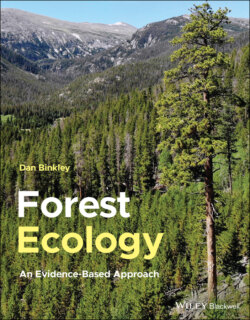Читать книгу Forest Ecology - Dan Binkley - Страница 47
Droughts Affect Trees, Beetles, Forest Structure and Fire Intensity
ОглавлениеInsects have coevolved with tree species, and favorable environmental conditions can change insect populations from low background levels to incredibly high numbers that overwhelm the ability of trees (and other vegetation) to cope. Most conifer species are hosts to one or more specialized species of bark beetles, and fungal spores spread by the beetles can kill trees (Chapter 10). The success of bark beetles may be higher in forests with trees that have experienced a strong drought, or winds that toppled large numbers of trees (where dying trees succumb to the beetles). These changes in forest structure result from interactions of drought, wind, and insects also change the potential of fire to affect the forest, with legacies that last for decades. In the Sierra Nevada mountains of California, droughts increase stress in pine trees, increasing the success of beetles. The beetles' fungal symbiont plugs the trees' water‐conducting sapwood, and needles dry and die. Dry needles ignite more easily and release more energy when burned than green needles, and forests with large numbers of recently killed pines have a high potential for running crown fires (Figure 2.22). The dry needles fall off within a few years, and the reduction in crown fuels reduces the potential for crown fires. After the woody material of dead trees falls to the ground, the high fuel loads can support high intensity surface fires.
The actual “story” of the environmental drought effects on the trees and forests would be only partially about water supply and tree physiology, and more about beetles, fires, and all the interacting legacies that shape forest changes over time. Most forests do not burn soon after beetle outbreaks, so the variety of post‐beetle forests that develop across landscapes can be quite broad.
FIGURE 2.22 Severe droughts can foster outbreaks of bark beetle populations, with legacies that last for decades or centuries. If a fire occurs shortly after the trees are killed, the dry needles can support a fire that leaps from crown to crown (upper), killing many (or all) of the surviving trees. A few years later, the dead needles have mostly fallen, and the risks of a spreading crown fire declines. Dead tree stems fall after a decade or so, just as small trees and shrubs are increasing in biomass. The accumulation of fuels near the ground can support surface fires that burn at high intensities.
Source: Stephens et al. 2018/Oxford University press.
